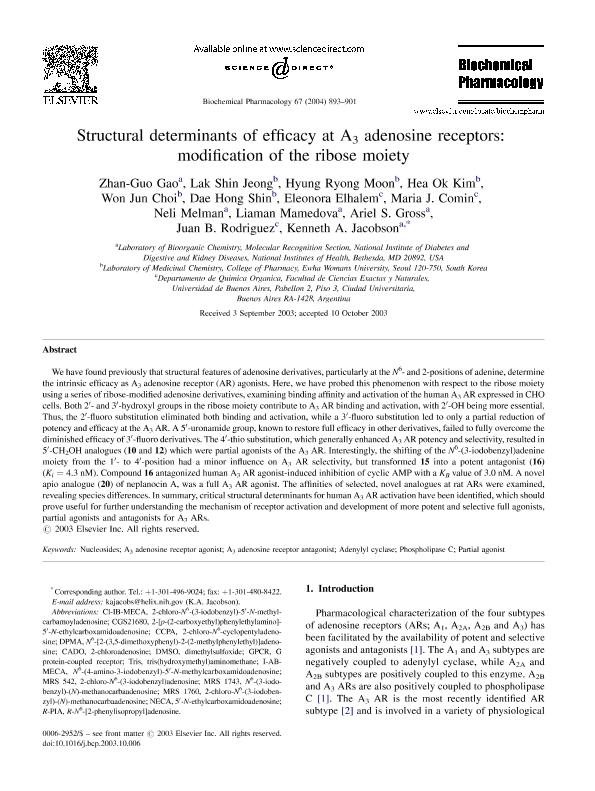Mostrar el registro sencillo del ítem
dc.contributor.author
Gao, Zhan-Guo
dc.contributor.author
Jeong, Lak Shin
dc.contributor.author
Moon, Hyung Ryong
dc.contributor.author
Kim, Hea Ok
dc.contributor.author
Choi, Won Jun
dc.contributor.author
Shin, Dae Hong
dc.contributor.author
Elhalem, Eleonora

dc.contributor.author
Comin, Maria Julieta

dc.contributor.author
Melman, Neli
dc.contributor.author
Mamedova, Liaman
dc.contributor.author
Gross, Ariel S.
dc.contributor.author
Rodriguez, Juan Bautista

dc.contributor.author
Jacobson, Kenneth A.
dc.date.available
2019-10-08T18:36:39Z
dc.date.issued
2004-03
dc.identifier.citation
Gao, Zhan-Guo; Jeong, Lak Shin; Moon, Hyung Ryong; Kim, Hea Ok; Choi, Won Jun; et al.; Structural determinants of efficacy at A3 adenosine receptors: Modification of the ribose moiety; Pergamon-Elsevier Science Ltd; Biochemical Pharmacology; 67; 5; 3-2004; 893-901
dc.identifier.issn
0006-2952
dc.identifier.uri
http://hdl.handle.net/11336/85345
dc.description.abstract
We have found previously that structural features of adenosine derivatives, particularly at the N6- and 2-positions of adenine, determine the intrinsic efficacy as A3 adenosine receptor (AR) agonists. Here, we have probed this phenomenon with respect to the ribose moiety using a series of ribose-modified adenosine derivatives, examining binding affinity and activation of the human A3 AR expressed in CHO cells. Both 2′- and 3′-hydroxyl groups in the ribose moiety contribute to A3 AR binding and activation, with 2′-OH being more essential. Thus, the 2′-fluoro substitution eliminated both binding and activation, while a 3′-fluoro substitution led to only a partial reduction of potency and efficacy at the A3 AR. A 5′-uronamide group, known to restore full efficacy in other derivatives, failed to fully overcome the diminished efficacy of 3′-fluoro derivatives. The 4′-thio substitution, which generally enhanced A3 AR potency and selectivity, resulted in 5′-CH2OH analogues (10 and 12) which were partial agonists of the A3 AR. Interestingly, the shifting of the N6-(3- iodobenzyl)adenine moiety from the 1′- to 4′-position had a minor influence on A3 AR selectivity, but transformed 15 into a potent antagonist (16) (Ki=4.3nM). Compound 16 antagonized human A 3 AR agonist-induced inhibition of cyclic AMP with a KB value of 3.0nM. A novel apio analogue (20) of neplanocin A, was a full A 3 AR agonist. The affinities of selected, novel analogues at rat ARs were examined, revealing species differences. In summary, critical structural determinants for human A3 AR activation have been identified, which should prove useful for further understanding the mechanism of receptor activation and development of more potent and selective full agonists, partial agonists and antagonists for A3 ARs.
dc.format
application/pdf
dc.language.iso
eng
dc.publisher
Pergamon-Elsevier Science Ltd

dc.rights
info:eu-repo/semantics/openAccess
dc.rights.uri
https://creativecommons.org/licenses/by-nc-sa/2.5/ar/
dc.subject
A3 ADENOSINE RECEPTOR AGONIST
dc.subject
A3 ADENOSINE RECEPTOR ANTAGONIST
dc.subject
ADENYLYL CYCLASE
dc.subject
NUCLEOSIDES
dc.subject
PARTIAL AGONIST
dc.subject
PHOSPHOLIPASE C
dc.subject.classification
Química Orgánica

dc.subject.classification
Ciencias Químicas

dc.subject.classification
CIENCIAS NATURALES Y EXACTAS

dc.title
Structural determinants of efficacy at A3 adenosine receptors: Modification of the ribose moiety
dc.type
info:eu-repo/semantics/article
dc.type
info:ar-repo/semantics/artículo
dc.type
info:eu-repo/semantics/publishedVersion
dc.date.updated
2019-09-27T17:12:09Z
dc.journal.volume
67
dc.journal.number
5
dc.journal.pagination
893-901
dc.journal.pais
Países Bajos

dc.journal.ciudad
Amsterdam
dc.description.fil
Fil: Gao, Zhan-Guo. National Institutes of Health; Estados Unidos
dc.description.fil
Fil: Jeong, Lak Shin. Ewha Womans University; Corea del Sur
dc.description.fil
Fil: Moon, Hyung Ryong. Ewha Womans University; Corea del Sur
dc.description.fil
Fil: Kim, Hea Ok. Ewha Womans University; Corea del Sur
dc.description.fil
Fil: Choi, Won Jun. Ewha Womans University; Corea del Sur
dc.description.fil
Fil: Shin, Dae Hong. Ewha Womans University; Corea del Sur
dc.description.fil
Fil: Elhalem, Eleonora. Consejo Nacional de Investigaciones Científicas y Técnicas; Argentina. Universidad de Buenos Aires. Facultad de Ciencias Exactas y Naturales. Departamento de Química Orgánica; Argentina
dc.description.fil
Fil: Comin, Maria Julieta. Consejo Nacional de Investigaciones Científicas y Técnicas; Argentina. Universidad de Buenos Aires. Facultad de Ciencias Exactas y Naturales. Departamento de Química Orgánica; Argentina
dc.description.fil
Fil: Melman, Neli. National Institutes of Health; Estados Unidos
dc.description.fil
Fil: Mamedova, Liaman. National Institutes of Health; Estados Unidos
dc.description.fil
Fil: Gross, Ariel S.. National Institutes of Health; Estados Unidos
dc.description.fil
Fil: Rodriguez, Juan Bautista. Consejo Nacional de Investigaciones Científicas y Técnicas; Argentina. Universidad de Buenos Aires. Facultad de Ciencias Exactas y Naturales. Departamento de Química Orgánica; Argentina
dc.description.fil
Fil: Jacobson, Kenneth A.. National Institutes of Health; Estados Unidos
dc.journal.title
Biochemical Pharmacology

dc.relation.alternativeid
info:eu-repo/semantics/altIdentifier/doi/http://dx.doi.org/10.1016/j.bcp.2003.10.006
dc.relation.alternativeid
info:eu-repo/semantics/altIdentifier/url/https://www.sciencedirect.com/science/article/pii/S0006295203008190
Archivos asociados
